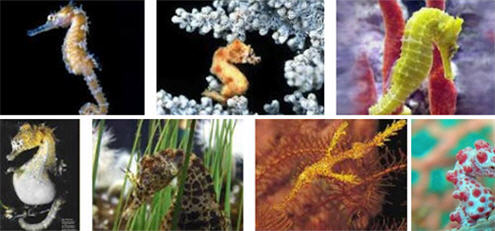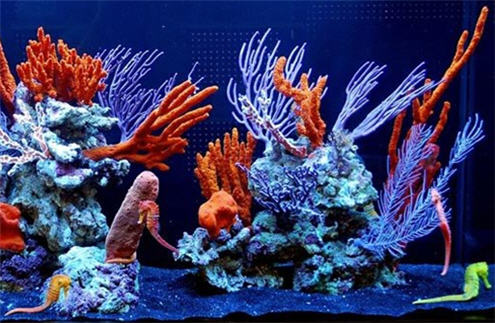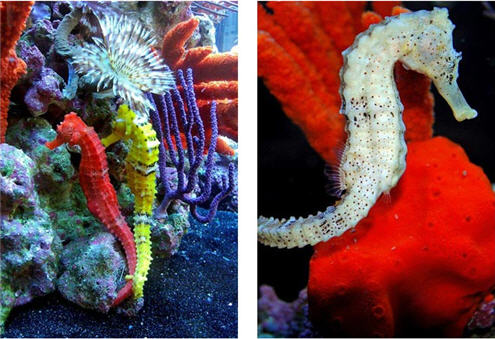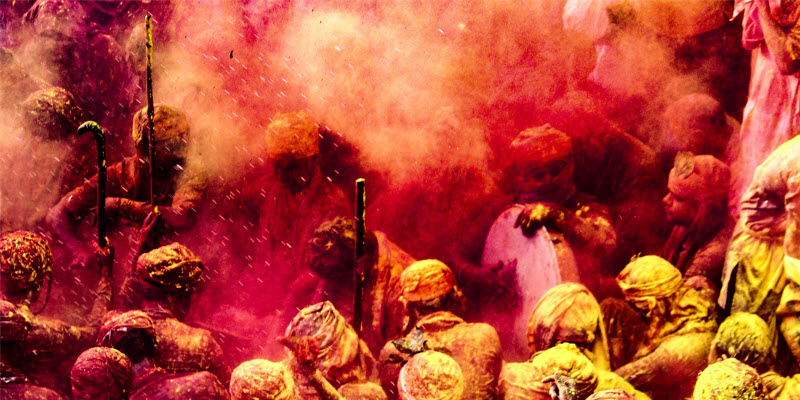colour in nature… seahorses, colour chameleons of the sea

Karen Haller

When it comes to animals being able to change colour, seemingly at will, I just had to know more… what I’ve learnt is just amazing. A friend of mine, Akil Gordon-Beckford just happens to be one of the leading UK Aquarium designers. What he doesn’t know about seahorses isn’t worth knowing. Here’s the abridged version…
colour protection
As Seahorses are very poor swimmers, they have come up with a very ingenious way to protect themselves from danger…. they are able to translate the colour that they see in their surroundings and accurately express it through their skin. This is known as habitat mimicry or crypsis. This ability to blend in with the surrounding habitat enables the seahorse to catch food whilst avoid being eaten. The perfect camouflage. How clever is that!
Thinking back to when I saw them diving, they were always brownish/green in colour. I see now they were blending in with the seaweed.

Seahorses turning on a stunning array of colours under the inflorescent blue lights of the aquarium.

A seahorse that is white has all of its colour cells contracted so that all the wavelengths of visible light are reflected back to the observer.
colour in courtship
We wear colours to show others how we are feeling about ourselves and how we want others to interact with us. Well, it appears Seahorses do the same thing. They are able to change colour as a social mechanism during courtship to communicate a readiness to mate and reinforce the bond. Both sexes change colour during this period to coordinate the transfer of eggs from female to the male.
Check out this video. The purple one is the male. Note the subtle colour changes especially at the beginning! That’s him greeting and initiating courtship… yes, you’re watching seahorse fore-play!
There are around 35 species of Seahorse and they all have the ability to change colour, however some species have a greater repertoire of colours than others. Their colour can also reflect health, stress levels, and over all physical condition.
How do they do it
They do this by expanding or contracting the pigment cells in their skin called chromataphores, which are controlled by muscle and nerve tissue. When the pigment cells are close to the surface of the skin, the colour is bright and clear; when the pigment cells are further away from the surface, the colour is muted and more diffuse.
They truly are the chameleons of the sea!
Sources: All images Advanced Aquarist
Video https://www.youtube.com/watch?v=fcett5sPx_0
About Akil: Akil Gordon-Beckford is one of the leading UK Aquarium designers. Bsc Honours in Biology and Ecology (specialising in animal behaviour and aquatic science). His company, Aquafront specialise in creating bespoke aquariums that connect people to the beauty and inspiration of nature.
You can follow Akil and Aquafront on Twitter @AkilGB and @Aquafront.



I love this post and the beautiful pictures. Seahorses have always held a fascination for me and it’s great to find out more about them.
I always wondered what the legal and ethical issues were about keeping seahorses in a private aquarium. Is it a good/bad thing to do?
This ‘colours of nature’ series is brilliant!
Hi Tamsin, aren’t they the most beautiful and graceful creatures! Akil was brilliant answering my many questions. The more I found out about them the more I wanted to know.
Good question about keeping them in private aquariums. I’ll ask Akil if he wouldn’t mind commenting on your question given he’s the aquarium expert!
Great to know you’re enjoying the series. I’m really enjoying discovering more and more about how amazing nature uses colour to communicate.
There are a few ethical issues surrounding the captive of care of wild seahorses. The major problem faced are the specialist feeding requirements and sensitivity to unstable water conditions. Wild Seahorses tend to only eat small live animals (zoo-plankton) as opposed to the usual frozen food that’s given to most aquarium fish. As a result many wild seahorses unfortunately perish due to starvation and poor acclimatisation to aquarium conditions.
Fortunately captive bred seahorses are readily available. Although still challenging they have a much higher survival rate as they are born already acclimatised to aquarium conditions and accept frozen food.
Seahorse are not for the faint hearted, so not the type of fish you buy on a whim. However they are really interesting and rewarding if the time is taken to understand how to provide a good standard of living for these beautiful animals.
Thanks very much Akil for taking the time to stop by and answered Tamsin’s question. I’m guessing you need to also keep a salt water aquarium which requires far more care than a fresh water one with your starter goldfish.
Really insightful what you wrote. Thanks again for agreeing to be interviewed.
Karen
Here’s a great link for more information on Seahorse care in aquariums
http://www.fishnetwork.tv/AdvancedAquarist/AdvancedAquarist/AmericanReef_-_Advanced_Aquarists_Edition/Entries/2011/10/23_Seahorse_Husbandry.html